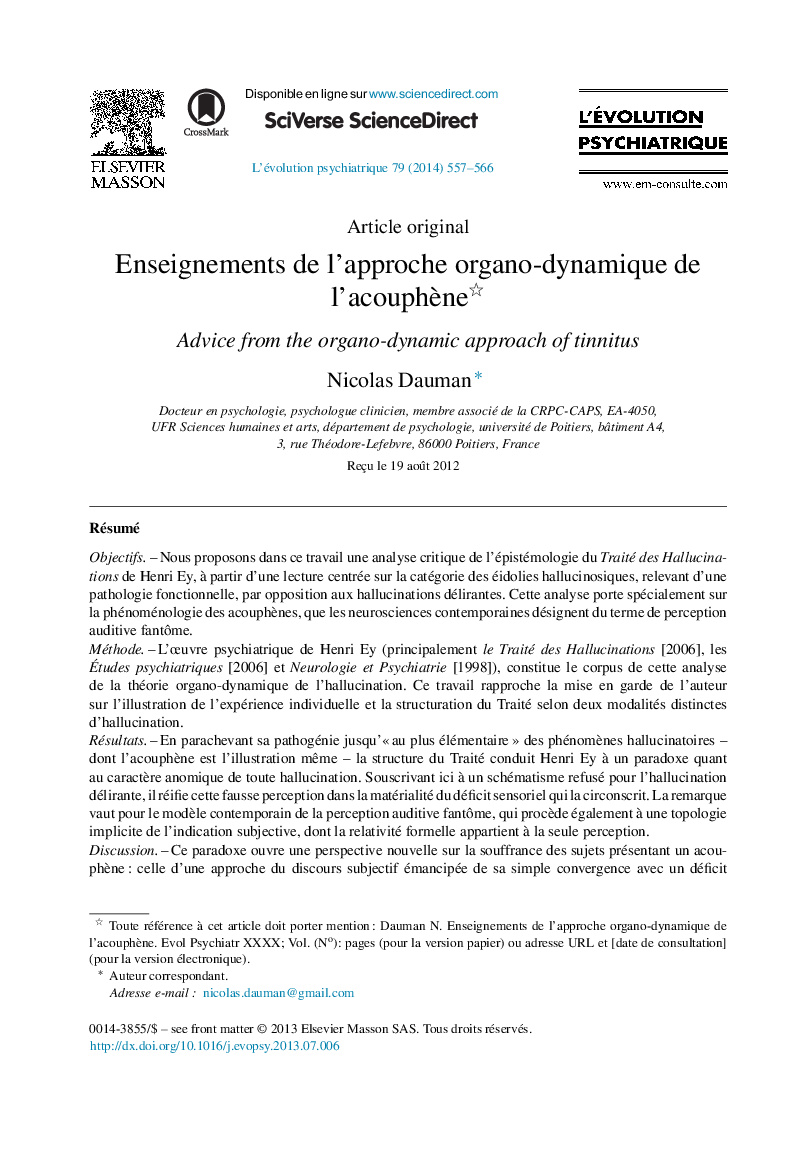| کد مقاله | کد نشریه | سال انتشار | مقاله انگلیسی | نسخه تمام متن |
|---|---|---|---|---|
| 908490 | 917180 | 2014 | 10 صفحه PDF | دانلود رایگان |

RésuméObjectifsNous proposons dans ce travail une analyse critique de l’épistémologie du Traité des Hallucinations de Henri Ey, à partir d’une lecture centrée sur la catégorie des éidolies hallucinosiques, relevant d’une pathologie fonctionnelle, par opposition aux hallucinations délirantes. Cette analyse porte spécialement sur la phénoménologie des acouphènes, que les neurosciences contemporaines désignent du terme de perception auditive fantôme.MéthodeL’œuvre psychiatrique de Henri Ey (principalement le Traité des Hallucinations [2006], les Études psychiatriques [2006] et Neurologie et Psychiatrie [1998]), constitue le corpus de cette analyse de la théorie organo-dynamique de l’hallucination. Ce travail rapproche la mise en garde de l’auteur sur l’illustration de l’expérience individuelle et la structuration du Traité selon deux modalités distinctes d’hallucination.RésultatsEn parachevant sa pathogénie jusqu’« au plus élémentaire » des phénomènes hallucinatoires – dont l’acouphène est l’illustration même – la structure du Traité conduit Henri Ey à un paradoxe quant au caractère anomique de toute hallucination. Souscrivant ici à un schématisme refusé pour l’hallucination délirante, il réifie cette fausse perception dans la matérialité du déficit sensoriel qui la circonscrit. La remarque vaut pour le modèle contemporain de la perception auditive fantôme, qui procède également à une topologie implicite de l’indication subjective, dont la relativité formelle appartient à la seule perception.DiscussionCe paradoxe ouvre une perspective nouvelle sur la souffrance des sujets présentant un acouphène : celle d’une approche du discours subjectif émancipée de sa simple convergence avec un déficit d’appareil. Au-delà d’une réification de l’indication subjective, l’étude de l’énonciation singulière de la souffrance personnelle se présente ainsi à l’horizon de l’épistémologie organo-dynamique.ConclusionsÀ notre époque où l’imagerie cérébrale semble annuler l’expérience intersubjective, par la représentation visuelle d’une indication insaisissable, Henri Ey nous permet de penser une exigence d’une étonnante modernité : une écoute psychothérapeutique n’est possible qu’à la condition d’être iconoclaste. S’il veut instaurer un dialogue avec le sujet qui souffre d’acouphène, le clinicien doit congédier de sa pensée les images qu’il s’en fait.
ObjectiveIn this article, we make a critical analysis of the Traité des Hallucinations by the French psychiatrist Henri Ey (1900–1977) and his organo-dynamic theory, that is focused on the functional pathology in contrast to the delirious hallucination. The analysis is dedicated in particular to the phenomenology of tinnitus (i.e. ringing in the ear[s]) that is currently labelled a “phantom auditory perception” by contemporary neurosciences.MethodThe analysis was conducted from a thorough reading of the psychiatric work of Henri Ey, mainly his important “Traité des Hallucinations” (2006), “Études psychiatriques” (2006) and “Neurologie et Psychiatrie” (1998). Following his warning regarding a pathological reality (hallucination) that cannot be seized “by draft and outlines”, in this report we address the understanding of the patient's discourse beyond its convergence with the experimental facts.ResultsBecause he wanted to include in the pathogeny of his treatise the “most elementary one” – e.g. tinnitus in the auditory sense – Henri Ey felt in the conception he did not support himself, that is to compare hallucination to a “kind of” perception. Having distinguished the delirious from the functional hallucinations (that correlate with sensory deprivation), he could not avoid reifying them within the sensory deficit, leading again to the concept of perception. This remark can be applied to the contemporary neurophysiological model of the “phantom auditory perception”, which also casts the patient's discourse on a frame with its relativity and proportions that belong to the field of perception (“elementary” vs. “complex” phenomena).DiscussionThe paradox of drafting functional hallucination as an elementary perception supports a new perspective on suffering from tinnitus, that is not restricted to an understanding of the convergence between the subjective discourse and a sensory deficit. Beyond a reification of the subjective indication arising inside the body (i.e. tinnitus), the study of the individual enunciation of the suffering appears on the horizon of the organo-dynamic theory. A psychodynamic approach of this new issue on tinnitus has been supported by the author and a colleague.ConclusionsWhilst today the magnetic resonance imaging seems to nullify the intersubjective reality, by showing visual correlates of this intangible phenomenon, Henri Ey allows us to recognize a surprisingly modern requirement: a psychotherapeutic listening to tinnitus patients has to be iconoclastic. If the aim is to set-up an individual dialogue with the tinnitus sufferer, the clinician must remove in his mind the images he created about it.
Journal: L'Évolution Psychiatrique - Volume 79, Issue 3, July–September 2014, Pages 557–566